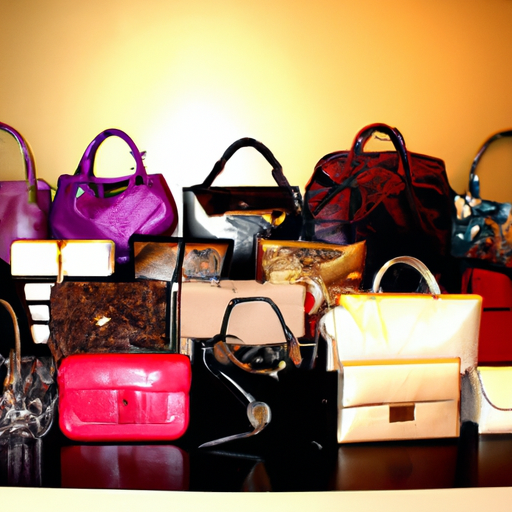Are you a fashion enthusiast looking to make smart investments? In today’s article, we will explore the world of designer bag investments and discuss the importance of diversifying your portfolio. With the fashion industry booming and designer bags gaining popularity as investment assets, it’s essential to understand how to strategically diversify your collection. By considering factors such as brand reputation, timeless designs, and limited editions, you can ensure a well-rounded and potentially lucrative designer bag investment portfolio. So, let’s dive into the world of fashion and discover how you can make the most of your investments.
Research Different Designer Bag Brands
When diversifying your designer bag investment portfolio, the first step is to research and consider different designer bag brands. Pay attention to their reputation and history in the fashion industry. Look for brands that have a wide range of designs, as this can indicate their ability to cater to different tastes and trends. Additionally, it is important to analyze the brand’s market performance to ensure they have a strong presence and demand in the fashion market.
Invest in Limited Edition or Collaboration Bags
Limited edition and collaboration bags can offer unique investment opportunities. Understand the value of limited edition bags as they are often produced in limited quantities, making them more exclusive and desirable. Consider collaboration bags with renowned designers or artists, as these collaborations often create hype and increased demand. Before investing in limited edition or collaboration bags, research the demand and resale value as this can vary significantly.
Explore Different Bag Styles
To diversify your designer bag investment portfolio, it is crucial to invest in different bag styles. Classic and timeless bag styles, such as a structured tote or a quilted shoulder bag, are always in demand and tend to hold their value well over time. On the other hand, trendy and fashion-forward bag styles can provide great returns if you are able to sell them at the right time. Additionally, consider diversifying with different bag sizes and shapes to cater to varying preferences and occasions.
Consider Different Materials and Textures
When investing in designer bags, it is important to take into account the materials and textures used. Investing in bags made from high-quality materials, such as genuine leather, ensures durability and longevity. However, exploring different textures like suede or patent leather can add unique elements to your collection. Research the durability and maintenance requirements of different materials to make informed investment decisions.
Analyze the Bag’s Functionality
Aside from aesthetics, considering the functionality of a designer bag is crucial. Evaluate the bag’s practicality and usability by assessing its storage compartments, closure mechanisms, and strap options. A well-designed bag that meets your needs and lifestyle will likely be more appealing to potential buyers in the resale market. Additionally, think about its versatility and ability to match different outfits, as this can increase its desirability and appeal.
Evaluate the Bag’s Resale Value
Knowing the resale value of designer bags is essential, especially if you plan to sell them in the future. Research the resale market for designer bags to understand which brands and styles hold their value well or even appreciate over time. Popular brands and styles with high resale value can be a great addition to your investment portfolio. Additionally, keep an eye out for limited edition or discontinued bags as they often have the potential for appreciation in value.
Diversify Across Different Price Points
To effectively diversify your designer bag investment portfolio, consider investing in bags from different price ranges. High-end luxury bags can serve as long-term investments and hold their value well, making them a solid choice for those looking for stable returns. However, exploring mid-range and contemporary designer bags can offer variety and potential for higher returns if you are able to spot emerging trends or up-and-coming brands.
Invest in Vintage or Pre-Owned Designer Bags
Vintage or pre-owned designer bags can be an excellent way to diversify your investment portfolio. Understand the appeal and value of vintage bags, as they often carry a sense of nostalgia and uniqueness. Research how to authenticate vintage bags and find reputable sellers to ensure you are investing in genuine pieces. Consider collectible and rare vintage bags, as they can hold significant value and offer the opportunity for substantial returns.
Stay Updated with Fashion Trends
To make informed investment decisions, it is crucial to stay updated with fashion trends. Follow fashion weeks and designer collections to keep track of emerging styles and popular designs. Research bag trends and popular styles to identify potential investment opportunities. Additionally, consider investing in bags that align with current fashion trends, as this can increase their desirability and resale value.
Consult with Experts
For valuable insights and expert advice, consider consulting with professional handbag resellers or collectors. They have a wealth of knowledge and experience in the designer bag market and can provide guidance on investment strategies and potential opportunities. Attending designer bag auctions or events can also offer valuable insights and opportunities for networking. Joining online forums and communities dedicated to bag investment discussions can provide a platform to exchange ideas and learn from fellow enthusiasts.
Diversifying your designer bag investment portfolio requires careful research, analysis, and consideration. By researching different designer bag brands, investing in limited edition or collaboration bags, exploring different bag styles, considering different materials and textures, analyzing the bag’s functionality, evaluating the bag’s resale value, diversifying across different price points, investing in vintage or pre-owned bags, staying updated with fashion trends, and seeking advice from experts, you can create a well-rounded and profitable designer bag investment portfolio. Happy investing!
